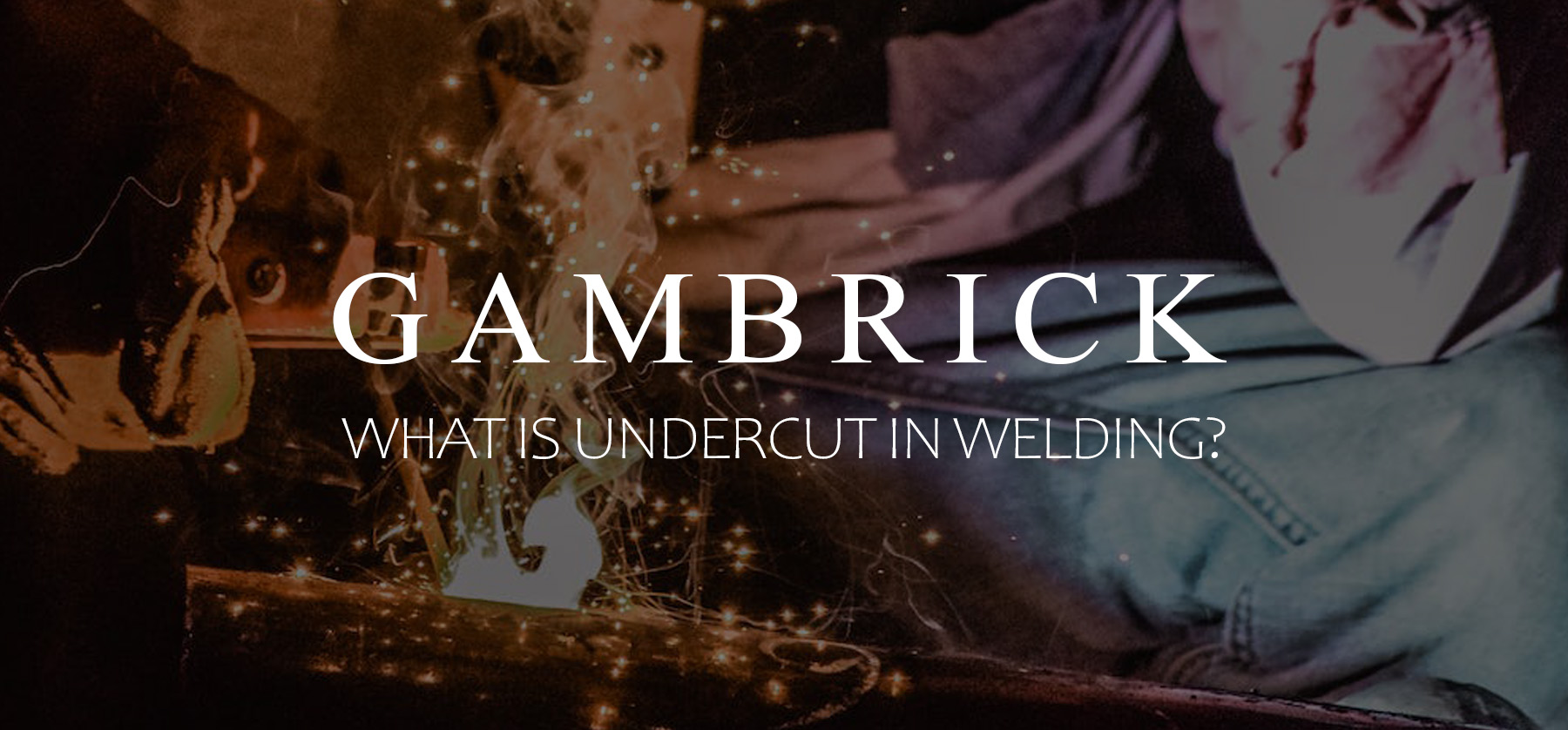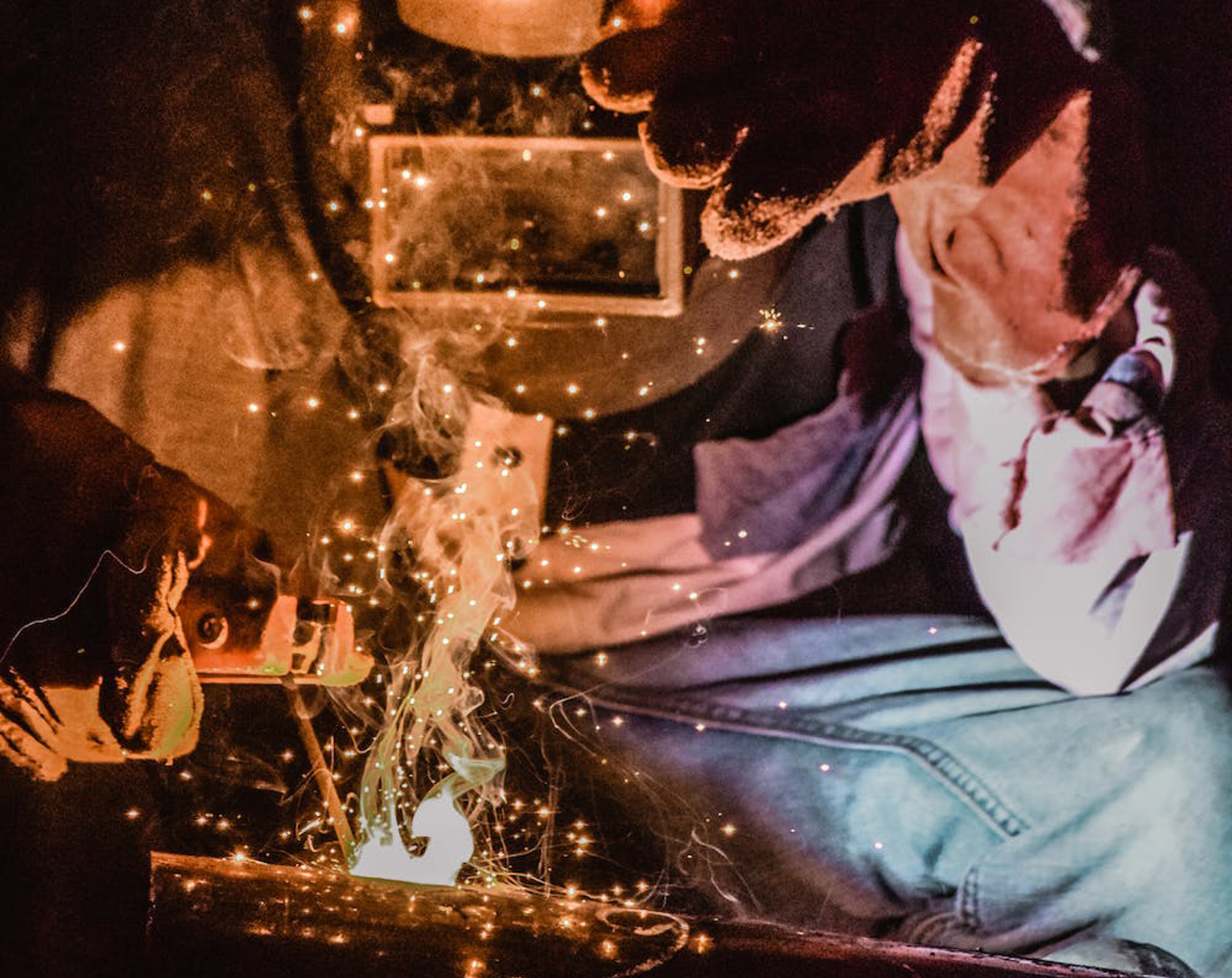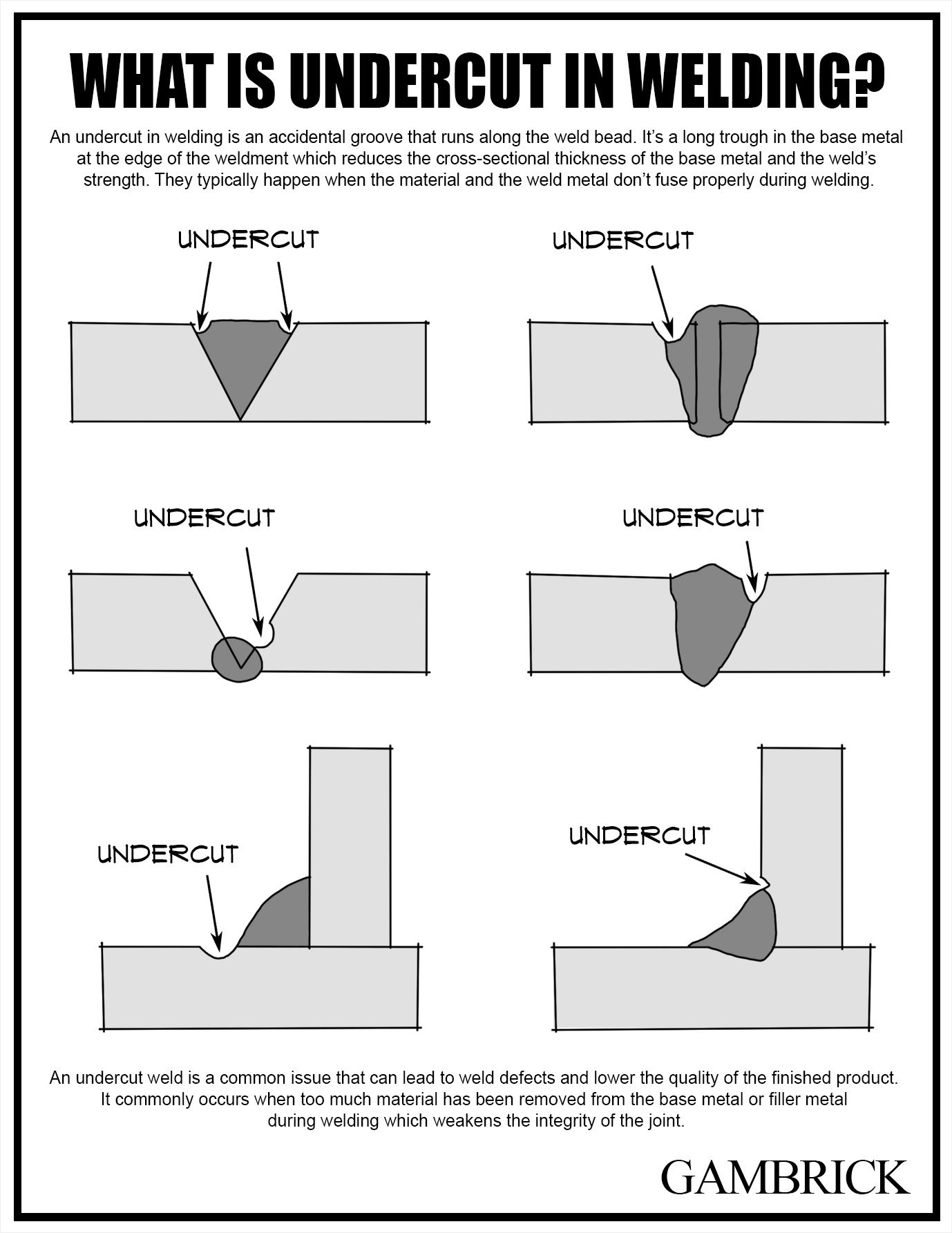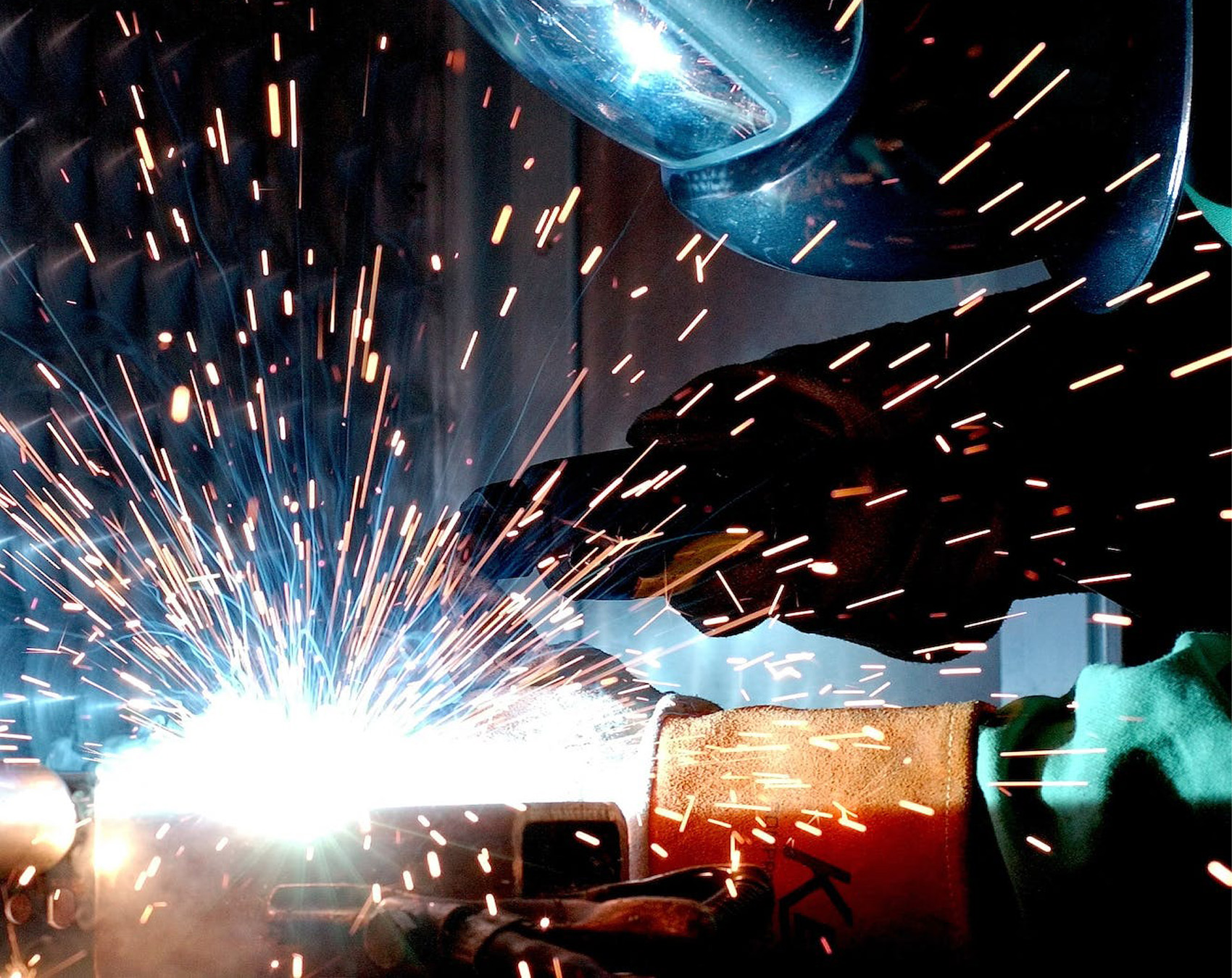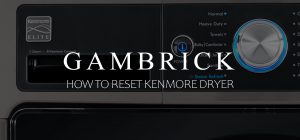What Is Undercut In Welding?
An undercut in welding is an accidental groove that runs along the weld bead. It’s a long trough in the base metal at the edge of the weldment which reduces the cross-sectional thickness of the base metal and the weld’s strength. They typically happen when the material and the weld metal don’t fuse properly during welding.
An undercut weld is a common issue that can lead to weld defects and lower the quality of the finished product. It commonly occurs when too much material has been removed from the base metal or filler metal during welding which weakens the integrity of the joint.
Undercuts and welding defects are often caused by incorrect settings on a welder, improper welding technique, or using an unsuitable welding rod for the job. Fortunately, there are techniques that can be used to identify undercuts early on and minimize their occurrence. In addition, there are methods for repairing existing undercuts in order to salvage damaged welds.
In this article, we’ll explore what undercut in welding is and how you can avoid it.
Types of Undercut
An undercut can either be considered internal or external.
External Undercut
External undercuts appear at the toe of the weld. In a fillet weld, it’s on the front of the joint, which will be visible during welding.External undercuts are more common than internal undercuts because the front surface is closer to the weld gun.
Internal Undercut
Internal undercuts can form on the bottom side of a butt joint which is at the root of the weldment. They’re also known as root undercut.
Causes & Effects Of An Undercut In Welding
Undercutting happens when the molten metal does not properly fill the groove in the welding joint and it appears as a channel or groove that’s been burned into the base material near the weld. The science of welding is complex and intricate. Welding flaws and complications such as undercut can drastically impact the quality, stability, and safety of the resulting product. Failing to fill the groove can directly lead to metal fatigue and a potential failure in the welded structure. This creates a weak weld that’s prone to breaking.
Several factors lead to undercutting when welding, which includes:
- Poor technique
- Improper current settings
- Incorrect travel speed while welding
- Inadequate filler material
- Improper electrode angle
The consequences of undercut in welding are reduced strength and structural integrity, increased stress concentration, susceptibility to fractures, or complete failure in severe cases.
To ensure that welds are consistently reliable and secure, welders must prioritize skillful technique, correct welding settings, and should only use appropriate materials to minimize the occurrence of an undercut welding defect.
What Can Lead To An Undercut
There are a few common mistakes which can cause an undercut in welding. In most cases, the main cause of undercuts is a mistake by the welder. For this reason, undercuts are avoidable and usually repairable.
Improper Current Settings
Improperly adjusting the current settings can cause an undercut. When the welding current is set too high, it generates excessive heat leading to an over-melting of the base metal’s edges. As the molten metal flows beyond the weld area, a groove is left behind which compromises the structural integrity of the weld joint.This groove of material is called an undercut.
An undercut not only diminishes the weld’s strength but also makes it prone to developing cracks, eventually leading to a premature failure.
Maintaining an appropriate balance between the welding speed, arc voltage, arc length and current is essential to ensure a smooth and seamless joint.
Incorrect Travel Speed
An undercut in welding can be caused by incorrect travel speed while welding. As the welder navigates their way through the joint, an excessively rapid or sluggish pace can result in the formation of a groove along the toe of the weld. This phenomenon, which reduces the effective throat thickness, may eventually culminate in cracks and even catastrophic failure.
Mastering the art of managing travel speeds while welding is very important for both professional and amateur welders. Controlling your weld speed helps ensure a more durable and dependable joint that can withstand the test of time.
Inadequate Filler Material
Choosing the right filler material is way more important than some might think. If a poor material is chosen it could lead to an internal undercut along with many other defects. This unfortunate occurrence stems from using an improper material that cannot provide sufficient support to the molten pool. This can cause it to sag and ultimately give way.
To avoid such failures, welders must pay careful attention to their filler material based on the specific welding application. This helps safeguard the quality and reliability of their work and helps prevent undercuts.
Wrong Shielding Gas For The Job
Shielding gas plays a crucial role in the welding process. It helps maintain the integrity and quality of the weld and may prevent undercuts. An improper choice of shielding gas or its incorrect usage can lead to an undercut.
For example, using a gas with a higher oxidizing potential, such as carbon dioxide, or a higher gas flow rate could lead to an undercut in the weld.
To make sure this doesn’t happen, welders should analyze their job and change their shielding gas as needed.
High Arc Voltage
Voltage effects the total amount of heat put into the weld. As the voltage level increases, more heat enters the weld zone. This causes more base metal to melt which has a big impact on the weld.
Excess heat creates a larger cavity which may not be totally filled. This can cause undercuts to appear on the sides of the weld due to a lack of filler material. To prevent this from happening, turn down the voltage.
Arc Length
A long arc length can create an undercut in welding. This can happen because a long arc doesn’t distribute heat energy evenly to the weld zone. Some areas receive more heat and melt properly, while others solidify early because of low heat.
The imbalance of heat can cause undercutting. To prevent it, make sure to maintain the proper arc length throughout the weld.
Edge Preparation
Dirt on the welding surface can block heat transfer. This can cause undercutting from a lack of fusion between the base metal and filler. To help prevent undercut, simply clean the material before you start welding.
If the material surface isn’t properly prepared before welding, its ridges and craters can cause bad heat penetration, bad liquid flow, and over/under-sizing. This can also cause undercutting. But it’s easily prevented by preparing the material and smoothing the surface. Use a grinder or sandpaper to remove small bumps and grooves.
Electrode Angle
The angle you weld at helps determine whether or not the weld will be correct or have undercut. An improper electrode angle can cause uneven heat int the weld area. One edge can overheat and melt into the weld pool which creates an undercut. In contrast, the other side can solidify early which can also cause an undercut.
To prevent undercuts, make sure to maintain a proper work angle at all times throughout the weld.
Wrong Electrode Size
If your electrode is too big for the job, excessive filler enters the pool and builds up in the mid-section of the groove because of higher surface tension. And because of the larger stick diameter, the heat is also more scattered. Both issues can cause an undercut.
But an electrode that’s too small can also cause problems. The filler metal can be insufficient to fill the joint which can create an undercut at the edge of the bead.
To avoid undercut, make sure to use an electrode that’s the correct size for the weld.
Welding Technique
Proper weaving is when you move across the weld and stop briefly at the sides. An inexperienced welder can cause undercuts at the points of the weave that touches the groove fillet’s edges. This can happen when the welder passes the electrode too quickly by the joint’s edges which allows premature cooling of the molten pool.
To help prevent undercut, make sure to use the proper technique throughout the weld.
How To Avoid Or Minimize Undercutting When Welding
The art of welding demands precision and attention to detail. This is especially true when it comes to avoiding or minimizing undercutting. Undercut welds typically occur when the weld metal fails to fill the crater formed at the toe of the weld. The result is a weak point in the joint.
To combat this issue, welders must consider several factors that can greatly influence the quality of the weld.
- Select the appropriate welding process and electrode angle size based on the material to be welded. This ensures optimal penetration and fusion of the materials.
- Carefully control the welding speed and heat input. Sudden changes in either can lead to undercutting. For example, maintaining a steady travel speed will distribute the heat evenly and minimize the possibility of burning away material.
- Mastering the correct welding angle and technique. Proper positioning can significantly reduce pressure and stress on the joint. This allows for better overall adhesion which can prevent undercutting.
By incorporating these factors into your welding routine, you can effectively avoid or minimize undercutting. The result is more durable and aesthetically pleasing welds.
Welding Techniques For Repairing An Existing Undercut
Once you fund an undercut that’s unacceptable, there are a few ways to fix it. There are a few welding techniques that can restore the integrity of the welded joint while ensuring longevity and structural strength. Mistakes made due to poor welding techniques can generally be fixed with a new weld. But be careful when repairing an undercut joint. Doing it improperly could make things worse. In some cases it’s best to grind out the old weld and create a new one.
- Use a grinding wheel or a flap disc to carefully remove the undercut’s sharp edges. This makes the weld more uniform and less prone to stress concentration.
- Employ a weave or pausing method with a lower current setting to promote efficient heat distribution. This allows the filler weld metal to fully penetrate the groove for optimal fusion.
- Adjust the welding angle can prevent excessive heat concentration in specific areas. This technique results in a more even weld bead profile.
With an understanding of how undercutting forms, welders can take steps to prevent it. This promotes high-quality and durable welded structures that last.
Tips For Identifying & Measuring An Undercut
Accurately identifying and measuring undercuts can help prevent weak joints and structural failures. An undercut is a groove that forms at the edge of a weld, typically due to excessive heat. The result is a loss of base metal thickness and a weaker joint.
- To identify an undercut, keen observation in a well-lit environment is essential. Look out for any visible grooves or irregularities along the welding seam.
- To measure the depth of an undercut, a carefully calibrated fillet weld gauge or a bridge cam gauge should be employed.
Tools provide precise measurements of the undercut. This helps ensure that the welding work conforms to quality standards.
Inspectors should continuously hone their skills in interpreting welding symbols and blueprints to understand the acceptable undercut limits for each project.
An adept welding inspector should always stay informed on the latest inspection techniques and technologies, adopting a proactive approach to maintaining weld quality and safety.
Tips To Avoid Welding Undercut
Here are some tips on how to prevent undercut in welding:
- Current: Make sure to use the correct current. Lowering the current can also reduce overheating which helps achieve proper fusion. If you’re seeing long, uniform undercuts, lowing the current may fix the problem.
- Voltage: Using the wrong voltage is another common cause of undercuts. The right voltage produces no undercuts with a smooth finish and an even bead.
- Edge Well: Maintain your fillet grooves by keeping them smooth and clean.
- Don’t Rush: Weld slower to provide time for mixing which helps avoid early solidifying.
- Be Steady: Weave in a steady and controlled manner while delaying your stay at the edges a bit. This helps ensure proper fusion and avoids undercut.
- Fillers: Always make sure to use the correct filler material.
- Angle: Always maintain a weld angle that deposits filler evenly in the weld pool.
- Electrode Size: The electrode should match the size of the weld and material you’re working on.
- Shielding: Make sure the gas mix is correct for the job.
- Stable Arc: Always maintain a stable arc length throughout the weld.
How Much Undercut Is Acceptable?
It’s best to avoid undercut as much as possible, however, a small amount can be acceptable. Most welders consider anything below 0.5 mm (.02 in.) to be safe on most projects. If you’re not adhering to strict quality assurance rules, you can decide based on a visual inspection, joint type and thickness, and the strength of the material. However, I recommend keeping undercut to an absolute minimum.
If you’re unsure, consult the standard guidelines set by the American Welding Society (“AWS”). According to AWS D1.1 Code, any undercut below 1/32” is considered harmless, even if it runs the entire weld length. The high-side limit is 1/16”. Even a small section of undercut deeper than 1/16” is considered a failed weld.
If you’re within the range of 1/32” to 1/16”, the quality inspector has to find the total length of undercuts falling into this range. This includes all long and single undercuts. In a 12” section, the total length of these undercuts must not exceed 2” for the part to pass.
Final Thoughts On Welding Undercuts
Undercutting can be a major issue when welding. It can lead to weak joints and possible structural failure if not fixed properly. However, by understanding the causes of undercutting and utilizing proper techniques welders will have an easier time avoiding and minimizing undercut formation in their projects.
These include:
- Selecting the right filler material
- Controlling welding speed and heat input
- Mastering the correct welding angle and technique
- Using grinding wheels or flap discs for repair
Properly executed undercuts offer several benefits which include:
- Increased strength of joints
- Better adhesion between materials
- Improved aesthetic appeal of welds
- Reduced stress concentration points on the joint line.
Utilizing these principles is essential to ensure successful outcomes with any welding project.
What Is A Weld Puddle?
A weld puddle is a molten pool of metal created by welding. This heated area is made as the welds join two pieces of metal together at extreme temperatures. Once formed, welders use tools to manipulate the weld puddle while making sure it remains within certain parameters and provides a strong bond between the pieces being welded.
The shape and size of a weld puddle differs depending on the type of weld used, the thickness of the metal being welded, and other related factors. It’s important to understand how weld puddles work in order to create high-quality welds that are strong and durable.
What Is Wire Welding?
Wire welding uses an electric current to effortlessly meld two pieces of metal together. The result is a strong and durable bond. The technique, also known as Gas Metal Arc Welding (GMAW) or Metal Inert Gas (MIG) welding, utilizes a continuous, consumable wire electrode and shielding gas to protect the weld pool from atmospheric contamination.
As the electrode rapidly melts, it adheres to the work-piece, creating a flawless fusion of materials.
Wire welding is noted for its remarkable versatility, as it can be employed in various industries ranging from automotive to aerospace. It’s a truly captivating process that showcases the astonishing potential of human innovation when it comes to combining science, art, and skill to manipulate materials in ways once thought impossible.
What Is The Main Cause Of Undercut In Welding?
Undercut in welding most commonly occurs from excessive heat by high current and voltage settings or if the travel speed is too fast. But it can also be caused when the electrode moves away from the weld pool too soon or if the edges are not properly cleaned of dirt or grit. Improperly prepared welding surfaces may also block heat transfer which can cause undercutting.
Does Undercut Weaken A Weld?
Undercut can weaken a weld joint’s structural integrity which may cause premature failure. These areas are typically the first to crack under stress. Undercut can also decrease a joint’s strength by trapping in water and dirt. Excess water around the joint can cause corrosion in an already weakened area.
What Is Undercut In Welding?
An undercut in welding is an accidental groove that runs along the weld bead. It’s a long trough in the base metal at the edge of the weldment which reduces the cross-sectional thickness of the base metal and the weld’s strength. They typically happen when the material and the weld metal don’t fuse properly during welding.
An undercut weld is a common issue that can lead to weld defects and lower the quality of the finished product. It commonly occurs when too much material has been removed from the base metal or filler metal during welding which weakens the integrity of the joint.
Undercuts and welding defects are often caused by incorrect settings on a welder, improper welding technique, or using an unsuitable welding rod for the job. Fortunately, there are techniques that can be used to identify undercuts early on and minimize their occurrence. In addition, there are methods for repairing existing undercuts in order to salvage damaged welds.
